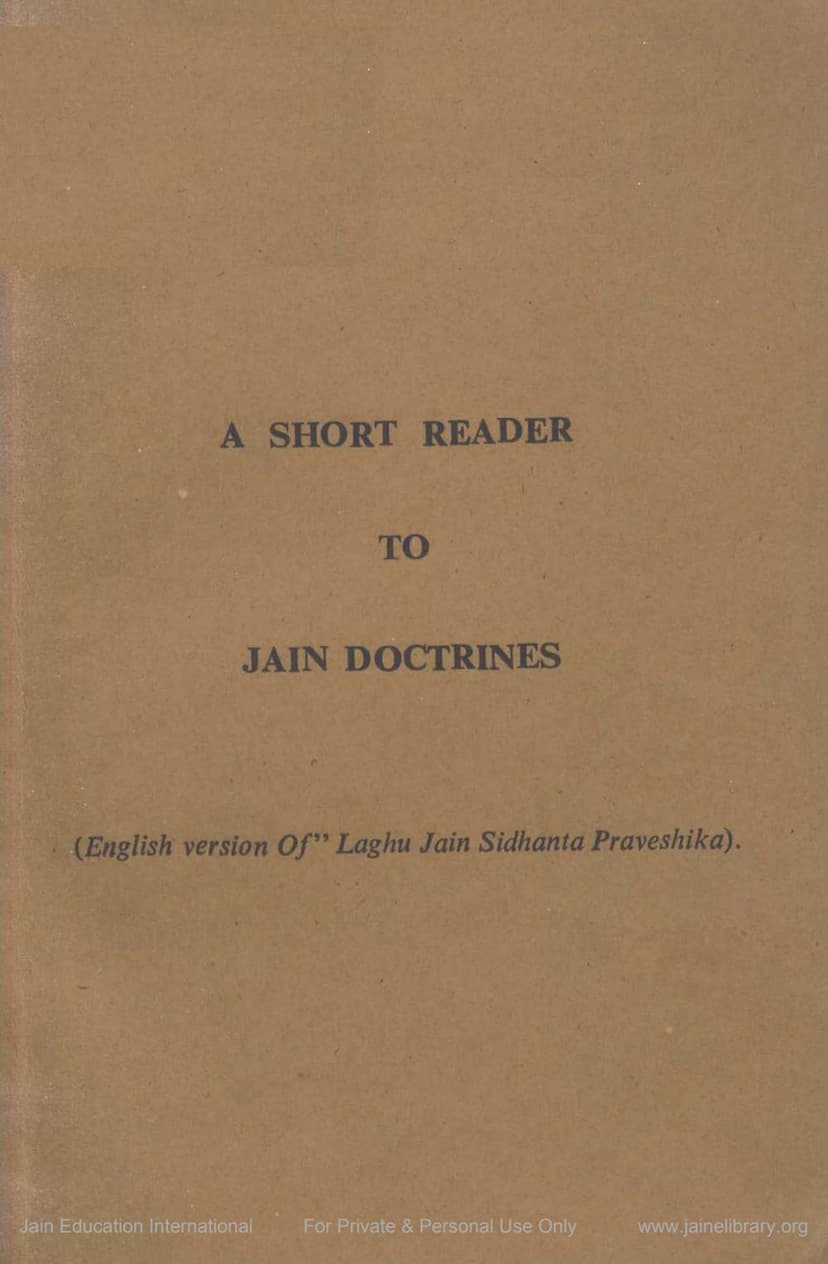Short Reader Of Jain Doctrines
Added to library: September 2, 2025

Summary
Here's a comprehensive summary of the Jain text "Short Reader of Jain Doctrines" by Hemchand Jain, based on the provided pages:
Overall Purpose and Context:
"A Short Reader to Jain Doctrines" is presented as an English translation of the Hindi work "Laghu Jain Sidhanta Praveshika." Its aim is to introduce seekers of truth to the fundamental principles and philosophical intricacies of Jainism. The book is a response to the widespread restlessness and search for happiness in materialism, asserting that true happiness lies within the soul itself. It acknowledges the influence of Pujya Shri Kanji Swami in guiding people towards this realization.
Core Jain Philosophical Concepts Introduced:
The book systematically breaks down key Jain doctrines through a question-and-answer format, covering the following:
1. The Cosmos and Its Constituents:
- Cosmos: Defined as the collective existence of six self-existing, uncreated, and beginningless substances.
- Substance (Dravya): Characterized as a mass of infinite, inseparable attributes (Gunas).
- Attribute (Guna): Qualities that exist in all parts and modifications of a substance.
- Modification (Paryaya): The functioning part or activity of an attribute.
- Types of Attributes:
- Common Attributes: Exist in all substances (infinite in number, but six main ones are existence, functionality, changeability, knowability, constancy of individuality, and shape formation).
- Specific Attributes: Found only in a particular substance.
- The Six Substances:
- Soul (Jiva): Possesses consciousness, knowledge, belief, conduct, bliss, and region-changing capacity. It is an immaterial (arupi) substance.
- Matter (Pudgala): Characterized by touch, taste, smell, color, and region-changing capacity. It is a material (rupi) substance.
- Types of Matter: Atom (Parmanu - indivisible) and Molecule (Skandha - union of atoms).
- Molecules (Varganas): Classified into categories like Ahar (body-making), Taijas (luminous), Bhasha (speech), Mano (mental), and Karman (karmic matter).
- Ether (Dharmastikaya): The passive cause of motion. Immaterial.
- Anti-Ether (Adharmastikaya): The passive cause of rest. Immaterial.
- Space (Akasha): Provides accommodation to all other substances. Immaterial.
- Divisions of Space: Universe (Lokakash) and Non-universe (Alokakash).
- Time (Kala): The passive cause of functioning. Immaterial.
- Types of Time: Real Time (Kalanu) and Conventional Time (Year, month, etc.).
2. The Soul (Jiva) and Its Attributes:
- Sentience (Chetana): The defining characteristic of the soul, involving perception and knowledge.
- Perceptional Sentience (Darshan Chetana): Undifferentiated perception (Ocular, Non-ocular, Clairvoyant, Omniscient).
- Knowledge Sentience (Jnan Chetana): Differentiated perception with particulars (Sensory, Scriptural, Clairvoyance, Telepathy, Omniscience).
- Knowledge Types: Sensory (Mati Jnan), Scriptural (Shrut Jnan), Clairvoyance (Avadhi Jnan), Telepathy (Manah Paryaya Jnan), Omniscience (Keval Jnan).
- Belief (Samyaktva/Shraddha Guna): The state of firm, doubtless faith in the true self and Jain principles.
- Conduct (Charitra): Passionless activity of the self, encompassing various stages from self-absorption to perfect passionlessness.
- Bliss (Sukha): The pure manifestation of the soul's inherent blissful nature.
- Power (Virya Guna): The soul's spiritual energy and potential for effort (Purushartha).
- Bhavyatva & Abhavyatva: Endowment of capacity and incapacity for salvation, respectively.
- Jivatva Guna (Life Attribute): The attribute of consciousness that gives substantiality to the soul.
- Vitalities: Material (Dravya Prana - 10 types, including senses, mind, speech, breath, age) and Spiritual (Bhava Prana - psychical sense and potential vitality).
- Alienability (Vaibhavika Guna): The attribute enabling perverted modifications, found in souls and matter.
- Non-affirmative Attributes: Undisturbedness, Accommodativeness, Constancy of Individuality, Subtleness.
3. Causality and Modifications:
- Origination (Utpada), Disappearance (Vyaya), Permanence (Dhrouvya): The three fundamental aspects of modification.
- Modifications: Shape (Spatial) and Substantive (Attributive), each further divided into Natural and Alienated.
- Cause:
- Substantive Cause (Upadan Karan): The real substratum or self-power responsible for a modification (e.g., clay for a pot).
- Instrumental Cause (Nimitta Karan): Auxiliary causes that are associated with the origination but do not perform the action (e.g., the potter for a pot). The book emphasizes that substantive cause is the true cause, and instrumental causes are conventionally recognized.
- Six Cases (Karkas): Doer, Deed, Means, Receiver, Producer, and Base, all found within each substance.
4. The Path to Liberation:
- The Seven Fundamental Principles (Tattvas): Jiva (Soul), Ajiva (Non-soul), Asrava (Influx), Bandha (Bondage), Samvar (Stoppage), Nirjara (Shedding), and Moksha (Liberation).
- Fallacies about Tattvas: The book details common misconceptions that deluded souls hold regarding these principles, which perpetuate the cycle of transmigration.
- True God and True Saints: Arihants (omniscient beings with bodies) and Siddhas (omniscient beings without bodies) are true Gods. Acharyas, Upadhyayas, and Sadhus are true saints.
- Piety (Dharma): Defined as refraining the soul from attachment and aversion (Ahinsa).
- Mithyatva (Perverted Belief): Explained in its five forms: Ekanta (one-sided), Viparita (contrary), Sansaya (doubtful), Ajnan (ignorance), and Vinaya (non-discriminating veneration).
- Perverse Knowledge, Doubt, Perversity, Indecisiveness: States arising from perverted belief.
- Non-abstinence (Avirati) and Recklessness (Pramada): Obstacles on the path to liberation, described with their various types.
- Yoga: The vibrational activity of the soul through mind, speech, and body.
- Nine Deities: Arihanta, Siddha, Acharya, Upadhyaya, Sadhu, Jina-Dharma, Jina-Vachan, Jina-Pratima, Jina-Mandir.
- Mangal: Right belief, knowledge, and conduct are considered auspicious. "Om," "Shree," "Swasti," and "Swastika" are symbolic representations of divine concepts and the soul's journey.
- Syadvada (Anekanta): The principle of conditional predication, essential for understanding the multifarious nature of reality.
Key Takeaways:
- Internal Happiness: True happiness originates from within the soul, not from external material possessions or experiences.
- Causality: The universe operates on principles of cause and effect, with the substantive cause being the primary driver of change.
- Self-Reliance: The soul has an independent capacity to undergo modifications, both pure and impure, and is not solely dictated by external forces like karmic matter.
- Right Understanding: Correct comprehension of Jain principles (Tattvas) is crucial to avoid fallacies and progress on the spiritual path.
- The Goal: The ultimate aim is liberation (Moksha), achieved through the destruction of karmic matter and the attainment of the soul's pure, blissful, omniscient state.